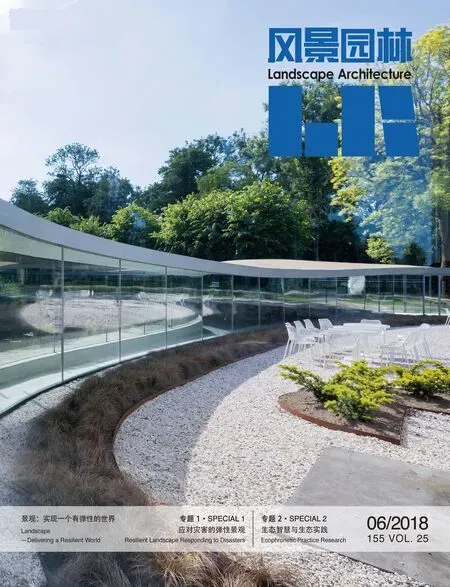弹性景观

现代风景园林学科中的概念、思想和理论来自于许多不同的方面,首先是学科自身的历史,包括古老的花园艺术,也包括人类各种建造活动所积累下来的营建智慧;其二来自于规划设计实践,现实中的各种复杂问题需要不断地研究,而研究成果又需在实践中得到应用、发展和完善,实践是风景园林理论产生的重要源泉;其三来自于不同学科之间的相互交叉与影响。由于风景园林涉及的范围非常广泛,研究和实践的领域与许多学科都有一定的重叠,不同学科的融合促进了风景园林理论研究的发展;其四来自于对其他学科已有的概念和理论的借鉴。科学的普及让许多专业名词变得耳熟能详,以至于被借用至包括风景园林学在内的很多学科中,用于解释某种类似的现象,“弹性”的概念就是如此。
在物理学中,弹性是一个非常古老的概念,是指当物体受到外力作用后发生变形、而当外力解除后变形会得到一定程度恢复的性质。能恢复到原状的变形叫弹性变形,而不能恢复到原状的变形,叫非弹性变形。当然,能否恢复到原状,与材料的特性、形态和外力的大小有着密切的关系。借助弹性的概念非常容易解释一个物体或者一个系统抵御外力影响的能力,以及一旦影响发生,物体或系统恢复原有形态的能力。许多学科,如生态学、工程学、经济学和社会学等都先后引入了弹性的概念,用以分析生态、工程、经济和社会等系统一旦受到外部环境的影响,特别是巨大的不利影响后,系统适应这种影响的能力。当然在不同的学科中,弹性的概念也会有所不同,比如在工程学中,弹性指的是一个工程受到干扰后,返回平衡状态或稳定状态的能力;而在生态学中,弹性指的是生态系统在受到外界干扰下,系统抗击冲击的能力、恢复的能力以及可能建立新的稳定系统的能力。弹性的概念对于深入研究和发展这些学科的理论都起到了一定的促进作用。
风景园林是处理人类建造环境与自然环境之间关系的学科,是研究人类如何在使用土地等自然资源的同时维持自然环境的健康的学科,或者说是创造适合人类使用的和生态平衡的人类生活境域的学科。人工的建造如何才能适应自然环境?两者如何才能达到平衡与和谐?弹性的概念为风景园林学带来了新的研究视角,即研究通过风景园林的途径使得不同尺度的建成环境具有更强的适应能力:当台风、地震、洪涝、干旱等灾害发生,我们的建成环境如何能够抵御灾害的影响?当建成环境遭受损害,如何能够尽快复苏?当社会、经济、人口和产业等因素巨变可能带来各种不确定的影响时,建成环境如何能够从容应对并实现可持续地发展?
近年来弹性景观已成为风景园林热点的研究领域。2018年IFLA世界大会将于7月份在新加坡召开,大会的3个主题之一是“未来的弹性”。配合IFLA 大会同时举办大学生设计竞赛和颁发IFLA亚非中东地区专业奖,前者的题目是“弹性景观”,后者的主题是“设计的弹性”。IFLA亚非中东地区专业奖在征集参评作品的文件中列出了2大类10小类的作品方向,既包含一些近年热点的弹性景观问题,如洪水的控制与水的管理、防范自然灾害和极端天气等,也包含文化传统、反恐、粮食安全等似乎与我们通常理解的弹性景观没有太多关系的领域。可见,风景园林领域的弹性概念已经变得非常宽泛,几乎无所不包,社会、经济、生态、文化和使用等等都可以与弹性相关,各个因素似乎都能用弹性来解释。于是,对弹性的理解,因为其内涵外延的不断扩展,也变得越来越难以把握。
不过弹性景观的概念还是为风景园林的研究和实践带来许多启发,让我们对景观有了更深的理解,对景观的价值有了更多的认识,也让我们对景观的复杂性、适应性、动态性和变化性有了更进一步的思考。

2018年6月8日
Resilient Landscape
The concepts, ideologies and theories of the modern Landscape Architecture have various sources. The first origin is the history of the discipline itself which includes ancient gardening art and the wisdom accumulated in human construction activities. The second origin is the planning and design practices during which complex problems were encountered, studied and resolved through explorations with the results applied, extended and perfected which has refined the Landscape Architecture theories. The third origin is the interaction among different disciplines. The extensive scope of Landscape Architecture leads to theoretical and practical overlaps with other disciplines and the disciplinary integration has promoted the development of Landscape Architecture theoretical research.The fourth origin is the adoption of existent concepts and theories of other disciplines. The dissemination of science has made many professional terms so familiar that some have been adopted to explain similar phenomena in other disciplines. The concept of resilience in Landscape Architecture makes a good case in this category.
Resilience is a time-honored term in physics referring the nature of an object to recover its shape or position after deformation by external force. If recovered to the original shape upon relief of the force, it is called Resilient Deformation, if not, the Non-resilient Deformation. It is certainly the properties,morphology of the object and the magnitude of the external force that largely determines whether the object can recover to its original state. Resilience is much comprehensible in delineating the ability of a certain object or system to withstand external impact and its capability to return to its original state once the impact arises. Therefore, resilience has been introduced into such disciplines as ecology, engineering, economics and sociology to analyze the adaptability of related systems to absorb environmental changes especially huge adverse impacts. Nevertheless different disciplines are interpreting resilience in different ways. For example,in engineering science resilience refers to the ability of a project to return to equilibrium or stability after being disturbed. In ecology,resilience refers to the ability of ecosystems in resisting external disturbance, recovering and establishing new stable systems. The concept of resilience has played a significant role in promoting the study and development of various disciplines.
Landscape Architecture is a discipline that deals with the relationship between human built environment and the natural environment, a discipline of how human utilizes natural resources such as land to maintain an ecological balanced and human available living realm. How can artificial construction adapt to natural environment to achieve balanced harmony? The concept of resilience brings new research perspective to Landscape Architecture. That is, how can Landscape Architecture make the built environment of different scales more adaptable? In face of disasters like typhoons, earthquakes, floods, droughts, how can the build environment withstand the strike? When the built environment is stricken, how can it get recovered quickly? And when the social, economic, demographic and industrial changes bring about various uncertainties, how could the built environment respond calmly for sustainable development?
In recent years, resilient landscape has become a hotspot among landscape research topics. IFLA World Congress 2018 will be held in Singapore in July this year. One of the three congress themes is Future Resilience. The result of Student Design Competition and the IFLA Asia-Asia Pacific-Middle East Professional Awards will be announced. The theme of student competition this year is Resilient Landscape, and that of the IFLA AAPME Awards is Resilience by Design. The award has 2 major categories and 10 subcategories for submission, including not only popular topics related with resilient landscape such as flood and water management, natural disasters and weather extremes, but also the topics that do not appear much associated with resilience landscape in general like culture and traditions, terrorism, food security and production system, etc. It shows that the concept of resilience in Landscape Architecture has become comprehensive to encompass the realms of social,economic, ecological, cultural and applicative aspects. Yet with all these factors explained in broadened connotation and denotation,resilience has also become an increasingly difficult concept for full grip.
Still, resilient landscape brings inspirations to research and practice of Landscape Architecture, makes contribution in deepening our understanding of landscape, in arousing our awareness of landscape values and in enlightening us about the complexity, adaptability, flexibility and variability of landscape.
June 8th, 2018

